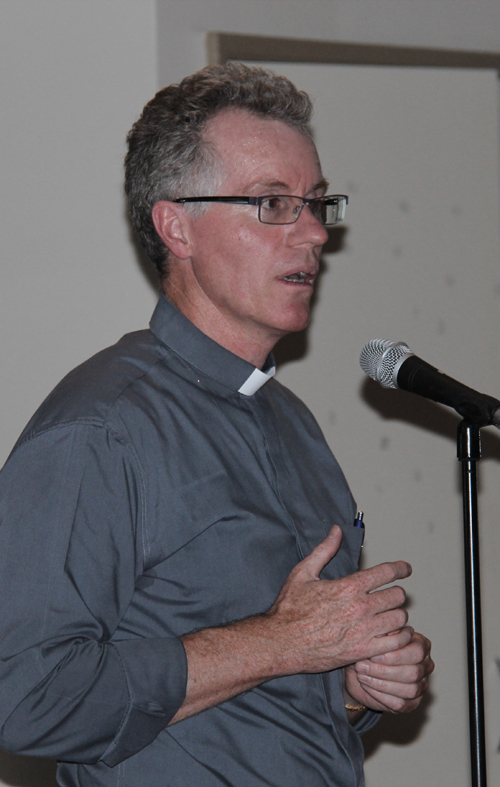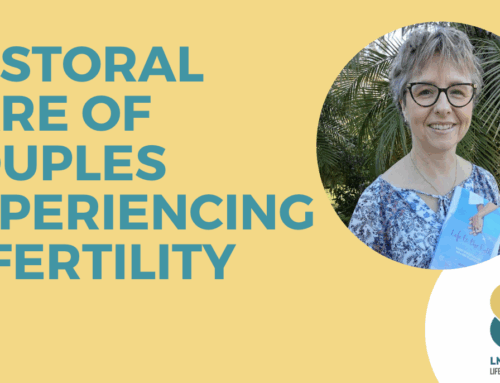Tricky Church Teachings: How to faithfully and effectively present the wisdom of the Church on sexuality
The following is a transcript of Fr Anthony Percy’s address to couples gathered at the MRC St Valentine’s Day Dinner Talk, 2013.Visit the Australian Centre for the Study of Sexual Assault and you will discover one of the deep wounds in the life of many Australians. Furthermore, go to a paper by Cindy Tarczon and Antonia Quadara entitled, “The Nature and Extent of Sexual Assault and Abuse in Australia” and the wound is laid bare.
To quote this paper based on 2005 figures:
- An estimated 1.3 million women and 362,400 men experienced an incident of sexual assault since the age of 15, according to results from the Personal Safety Survey 2005 (ABS, 2006a).
- This approximately translates to 1 in 6 women and 1 in 20 men.
To be more pessimistic still:
- Almost 1 million women (956,600, or 12%) reported having experienced sexual abuse before the age of 15. More than 90% of victims knew the perpetrator (ABS, 2006a).
- Of male respondents, 337,400 reported experiencing sexual abuse before the age of 15. Again, more than 80% of male victims knew the perpetrator.
- Two thirds of all respondents (67.6%) reported being sexually abused before the age of 11.
Things do look grim on the sexual front, not only in the “Land Down Under,” but worldwide. The average age for viewing pornography now is eleven, and what the young are now watching and witnessing is nothing like the Playboy magazines of Hugh Hefner’s generation. Just a simple entry into Google will yield a video of three men sexually attacking one woman. If you are not up to date on the matter, I suggest you go and buy a copy of Gail Dines’ book Pornland. It will shock and sadden. But then it will hopefully prepare you for the “war” that we are now in.
Chesterton said in 1926 that “there is more madness coming out of Manhattan than there is out of Moscow.” He foresaw that the next “heresy” the Church would face would be of a sexual nature. It is hard looking back on the second half of the 20th Century, and living as we are in the 21st Century, to deny his prophecy. What have we come to when we market bralets for seven year old girls?
And yet because sexuality is tied up with every fibre of our being it is not easy to identify the real causes of the sexual revolution. What might you identify as the root causes?
Culture
Let me suggest two things. The first relates to culture and the second is to do with human sexuality itself.
Jean Vanier, founder of l’Arche, began to notice a deep connection between the wounded human heart and disturbed sexuality as he began to live with people with disabilities.
There was so much anguish in that house that I sometimes felt completely overwhelmed. There were men drawn to homosexuality and masturbation, even to the point of exhibitionism. One man even walked through the village totally naked. I tried to understand and help them. …
It became evident to me during these difficult years that there is a link between the anguished, wounded heart, the cry of violence, and disturbed sexuality. It was necessary, first of all, to make the homes of l’Arche …. places where suffering hearts could find peace. Gradually, we were able to make them places of life, tenderness and friendship, indeed truly a ‘home.’ As the violence began to diminish, so did many manifestations of uncontrolled sexuality. The men began to take on a more human face. (Man and Woman He Made Them, 1989, p.3)
Vanier is on to something here. His experience surely doesn’t lie. Philosophers, theologians, cultural commentators and great thinkers are not wrong when they identify the desire to be loved and to love as the predominant, driving desire in human life.
And yet, human existence and human history tell us that this desperate desire to be loved and to love is often thwarted through sin, dysfunction and ego. When our greatest desire is not satisfied, when our greatest need is not met, dysfunction sets up its edifice and begins to reign in almost all areas of human existence – including sexuality. All of us know this to be true through our own familial experiences.
We are talking about culture here. This is why John Paul II’s Theology of the Body is such a revelation and revolution. George Weigel claimed that the Theology of the Body is a theological time-bomb. The reason he claimed this is because the pope’s teaching, given between the years 1979 and 1984, speaks of culture – meaningful and proper human experiences – and then, and only then, about sex.
When the French’s Bishops commissioned a study of John Paul’s pronouncements just prior to World Youth Day in Paris, 1997, they discovered that just 3% of them had to do with sex. Most of them had to do with culture. They were able to give an objective answer to those who were claiming the Church was obsessed with sex. Rather, it seemed the pope was obsessed with culture. And rightly so, since it forms the basis of society and sexuality.
Vanier has proved to be one of the great prophets of the 20th Century and beyond. His experience, in and through his life and work with the disabled, has heightened our awareness of the dignity of each human being, no matter what their human condition. For his part, John Paul II restored the prophetic nature of the papacy. The Church is not primarily an institution as such, but a voice, a prophetic utterance, just like John the Baptist, crying in the wilderness of human hearts.
At the centre of John Paul’s Theology of the Body are the original experiences. Up until his teaching, we have known just one original – Original Sin – with its very helpful insight into our diminished human existence in a world with sin. With John Paul’s emphasis on the Bible and on a philosophy called “phenomenology,” he discovered and developed Original Solitude, Original Unity and Original Nakedness – all human experiences found in the Bible prior to Original Sin. Here’s the essence of the pope’s approach:
- If we have an experience of solitude he claims we will come to know our bodies as symbolic.
- If we have an experience of unity he claims we will come to know our bodies as spousal.
- If we have an experience of nakedness he claims we will come to know our bodies as beautiful and free.
Now if this true, and it is, then sex itself is symbolic, spousal, beautiful and free.
Contrast this with the prevailing view peddled continuously and relentlessly on our billboards, in our magazines, on TV and on the internet. Take this dialogue from Sex and the City.
“After Miranda has a one night stand with a bartender, she is puzzled to hear him say afterward, ‘That was really special.’
‘Sure,’ she replies.
‘Can I get your phone number?’ he inexplicably continues.
‘Why?’ she asks.
‘So I can ask you for a date,’ he explains.
Miranda’s voice is thick with sarcasm as she tells him, ‘You don’t have to make believe you’re going to call.’
He finally leaves and encourages her to ‘stop by at the bar sometime.’
‘Yeah, great sex. Whatever.’ She waves him away.
A few days later the bartender shows up at her apartment and tells her, ‘I like you.’
Still suspicious, Miranda replies, ‘Translation: ‘I think you’re an easy lay and I’d like to have sex again.’
He protests that he doesn’t mean that at all and wants to take her to dinner.
Miranda explains her philosophy: ‘I can’t have dinner with you; I don’t even know you!’
‘But you slept with me!’
‘That’s a different thing.’” (Modern Sex, p. 49-50)
Now contrast Miranda’s view of reality with that of the Bible’s. The first reference to sex is found in the Book of Genesis. Adam discovers Eve and exclaims, “This at last is bone of my bones and flesh of my flesh” (Gen 2, 23). And then, “Therefore a man shall leave his father and his mother and hold fast to his wife, and they shall become one flesh” (Gen 2, 24). And then, “Now Adam knew Eve his wife, and she conceived and bore Cain, saying, ‘I have gotten a man with the help of the LORD’ (Gen 4, 1).
So, we are asked to make a choice. Either we accept Miranda’s take on sex which she describes as “a different thing” or we accept the image of sex as a “knowing” of the other and a forming of a one flesh union. The choice is quite clear. Either sex means something – something quite substantial – or it means nothing.
Of course I am not saying that we read the riot act to people about this, as if they have an either/or choice. The truth takes time to manifest itself, particularly when one has been living contrary to the truth. Truth is like this – it takes time – and so do people – they take time.
But silence is not an option. We surely owe our couples the truth that sex is an interpersonal act of knowing. It is a profound knowing of the other since you know them in the flesh, in the heart (emotions), in the will and in the mind. All symbolised beautifully by sexual foreplay and intercourse.
Pope Paul VI put it like this:
[H]usband and wife, through that mutual gift of themselves, which is specific and exclusive to them alone, develop that union of two persons in which they perfect one another, cooperating with God in the generation and rearing of new lives. (Humanae Vitae 8)
[Married] love is a love which is full and plentiful [pleno] — that very special form of personal friendship in which husband and wife generously share everything, allowing no unreasonable exceptions [undue reservations] and not thinking solely of their own convenience. Whoever really loves his partner loves not only for what he receives, but loves that partner for the partner’s own sake, content to be able to enrich the other with the gift of himself. (Humanae Vitae 9)
John Paul II develops this initially personalistic language of Paul VI in his Theology of the Body by describing the body and sex as symbolic, spousal, beautiful and free.
Again, I am not saying this is easy. We live a diminished human existence as a result of Original Sin. Sex is not exempt from the “wound.” But Christ has redeemed us and he has redeemed sex. John Paul II follows the Bible closely here. In the one breath we hear of sin and also the promise of redemption. The Bible never treats of sin in isolation – that really is the work of the devil who Jesus called an “accuser.”
Christ is not content to leave us to ourselves. By helping young people to see the deeper meaning of sex as symbolic, spousal, beautiful and free, wounded and yet redeemed, we give them a real head start in life. This should never be doubted.
Procreation dissociated from Sex
It was Freud – no friend of the Church – who said that all sexual perversion flows from the dissociation of procreation from sex. This claim still meets with great resistance today, particularly in Western Countries like our own, and perhaps consciously or unconsciously in our very selves. I say unconsciously, since the predominant message thrown at teenagers, right throughout their schooling, is that when it comes to sex, they should beware of STI’s and pregnancy. The message is not about love and babies, but about avoiding disease and pregnancy. This forms part of the narrative that Miranda has swallowed in Sex and the City.
Freud is not alone. Modern studies confirm his position. Anne Mitchell, associate professor at La Trobe University’s Australian Research Centre for Sex, Health and Society, explains the effect of easy access to the pill:
That is when the gap between puberty and marriage started to grow. In the past you got married to start a sex life. The pill was huge. It made the difference between the shame of having a baby out of wedlock (and not) … The gap between puberty and marriage means there is a lot of territory where you cannot expect everyone to be celibate.
The pill, because it has dissociated procreation from sex, and done so with tremendous ease, has led to less committed and more casual sex. Indeed, it opens to door to fornication and adultery as never before.
Mitchell is on to something here, just as Pope Paul VI was in 1968. He taught that sex is unitive, procreative and parental and that if you take away the procreative potential from sex in a deliberate manner, you take away the unitive aspect as well.
In other words, if we deliberately take away the procreative power of sex then we are also taking away its unitive power. This is so because the body is symbolic and spousal. The body makes present the person and its power to communicate love. Think of the five senses, they mean something in and of themselves, but also point beyond themselves. This is particularly true of the sense of hearing and touch in married love. Touch is the sense that communicates love. Touch points beyond itself. It is symbolic.
The diminishment of procreative potential is thus a diminishment of the person and his/her unitive potential. When a couple deliberately engage in non-procreative sex they not only lose their fertility, but they lose something very dear to their true selves.
In other words, the procreative and parental potential is intimately part of who they are and what they share in sex. The ability to procreate is not extraneous to their real selves. To deliberately diminish it is to affect their experience of unity.
None of this is easy, of course, confronting, as we are, a culture that is now sexually saturated. But as George Bernard Shaw wrote in his play, Back to Methuselah,
Life is not meant to be easy, my child; but take courage, for it can be delightful.
We might transpose this a little and say,
Sex is not meant to be easy, my child; but take courage, for it can be delightful.
A delight that God originally intended it to be!




